
There was a group of women squatting around a giant soup pot in Hanoi’s old market. They appeared like old friends gathering for a morning snack. Of course, I had to get closer to figure out what was going on. They were visiting and enjoying steaming bowls of pho. The pho vendor joyously poured a spoonful of MSG into the bottom of each bowl to start her pho assembly routine. The white crystals of magical flavor were part of her mise en place arranged around her. I was surprised but curious.
When I got back to the States, I asked my mom about such generous use of bột ngọt (MSG in Vietnamese; the term literally means sweet powder). “That’s how you do it in the markets,” she said, shrugging.
Years later, I described the situation to Mark Lowerson, a friend, street food expert and tour guide in Hanoi. He nonchalantly explained in his Aussie accent that you can always ask for just a little or no MSG -- xin một tí bột ngọt or xin không bột ngọt.
MSG as a Pho Friend?
Monosodium glutamate (MSG) is part of kitchen pantries throughout East and Southeast Asia. For many Vietnamese people, MSG is part of the flavor profile of pho.
During the Vietnam War, an ingredient like MSG was a luxury in northern Vietnam. Below is a poignant passage from Camilla Gibb’s wonderful pho-centric historical novel, The Beauty of the Humanity Movement. Hưng is a humble, very poor pho vendor who stubbornly continued his culinary craft through times of war and peace. Lan is a long-time neighbor who cares for him deeply and their conversation moves from post 1954 to around the early 2000s.
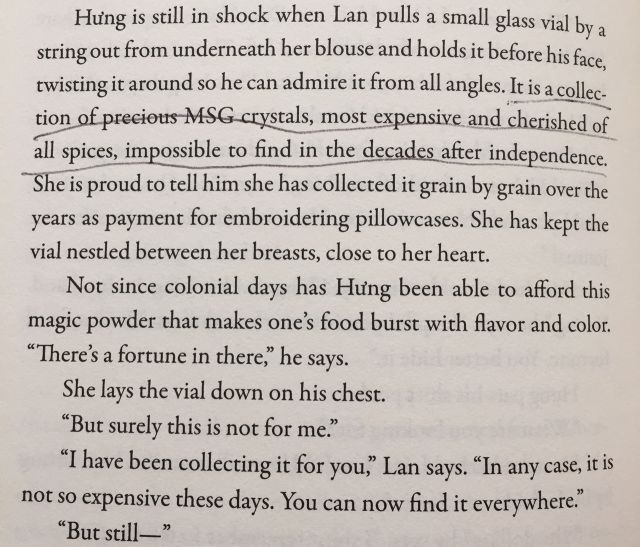
For as long as I can remember, my mom has always seasoned her pho broth with MSG. In the 1970s when we lived in Vietnam, there were scares about MSG -- that it could cause brain damage or even death. It didn’t stop Mom from using it; she and my dad knew how to filter news in Vietnam, especially during those crazy, tumultuous years.
After we resettled in America, we kept MSG in a little jar in the kitchen cupboard. No one in my family suffered from eating it. My mom did not liberally use MSG; it wasn’t on her grocery shopping list each time we went to an Asian market (where prices were cheap for Ajinomoto, the go-to Japanese brand of MSG).
Mom’s approach to cooking is old school, built on thoughtful techniques with few short cuts. Certain foods, however, needed MSG to be complete. I can’t imagine her not adding MSG to the pho broth that I make and freeze for her and my dad. In fact, I remind her to add bột ngọt and fish sauce to the finish the broth before using it.
Years ago, Stephanie Dinh, a chef and restaurateur in Little Saigon, told me that older Vietnamese ladies said that her pho was not legit because she didn’t put MSG in it. She was crestfallen because she'd worked really hard on her pho recipe, as well as her lovely S restaurant, which is now defunct. My friend Eric Banh of Ba Bar and Monsoon in Seattle has received one-line emails asking: Do you put MSG in your pho?
For a certain generation of Vietnamese, pho needs MSG. Younger Vietnamese chefs seeking to bring Viet food to a wider audience are damned if they do and damned if they don't use MSG!
In 2015 when I was intensely researching pho in Vietnam, I went to a couple supermarkets in Saigon and Danang. There, I noticed small jars of salt, pepper, and MSG on the shelves. They seemed novel. I didn’t take the mixture seriously until I got to Hanoi, where I saw similar stuff at certain eateries. They were either presented with dishes to be made into a dipping sauce with a squirt of lime, or as a seasoning.
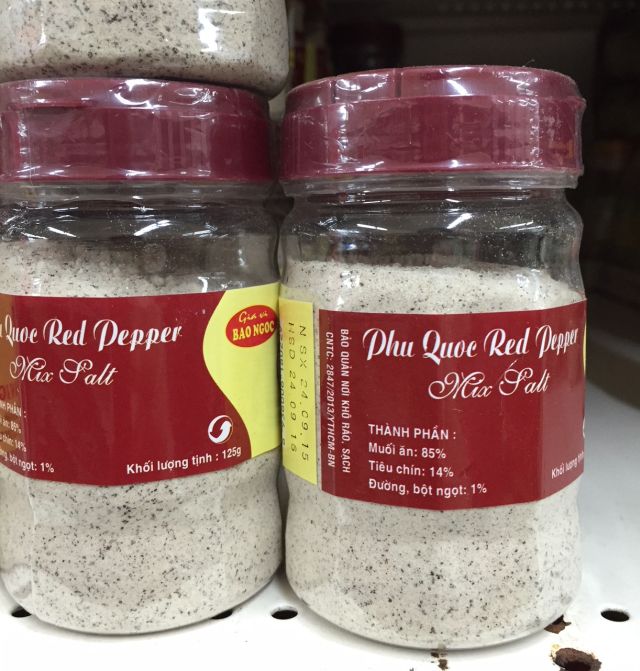
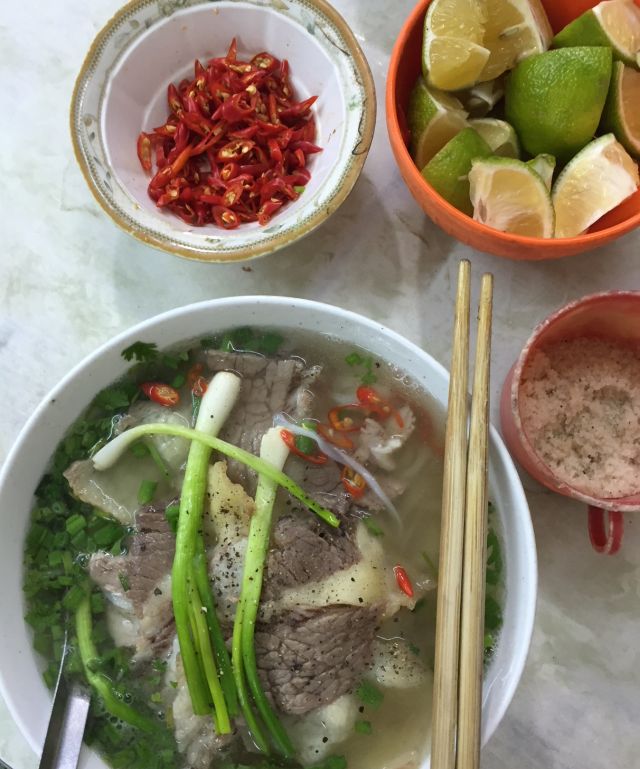
When I got a peek into the back of one Hanoi restaurant, I saw cooks blending the mixture themselves, using a scale to maintain a consistent ratio. I imagine that there was already MSG in the dishes they prepared. But given that Vietnamese food is highly personal, they let their customers be the ultimate deciders. If customers want extra umami oomph, they can add it themselves. (My friend Maki, born in Japan, raised in California and a trained professional chef, says her family had an Ajinomoto dispenser on the table at meal times.)
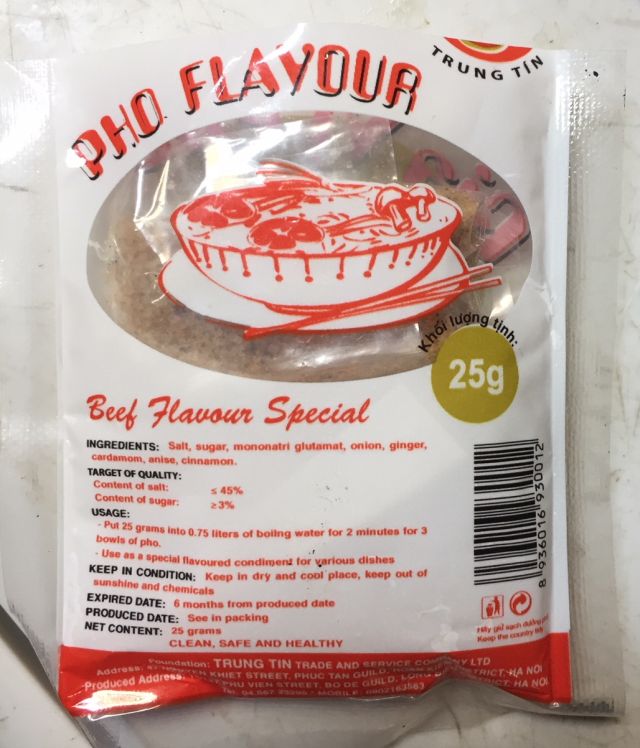
In Vietnam, there are many good restaurants and street food vendors who use MSG with restraint. Not-so-great joints rely too heavily on the crystals. For example, at one spot in Nam Dinh (the supposed birthplace of pho), we ordered bowls of pho with stir-fried beef and vegetables. I was with Mark, food stylist Karen Shinto, and other friends and we all asked for “một tí bột ngọt.” The tough looking lady cooks didn’t care much about our request. What we received were pho bowls full of MSG flavor; the broth and stir-fry topping were one dimensional.
I left most of my bowl uneaten. It was disappointing.
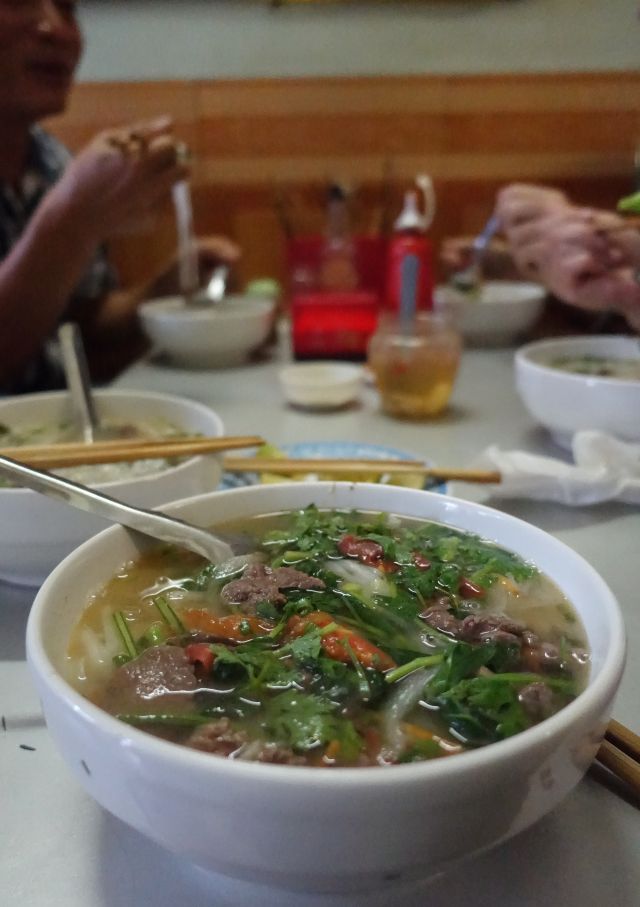
I’ve had similar experiences in America and have paid the bill and walked away. Fortunately, I have the option of spending my money and calories elsewhere.
MSG has Flavor
Some people have told me that MSG has no flavor, that it simply makes food taste better. I’ve tasted the crystals straight and they have a unique sweet-savory characteristic. The Vietnamese name, bột ngọt, nails that sweetness on the nose. When I add 2 or 3 shakes of MSG to a bowl of pho, the broth subtly changes. There’s an umami burst that makes the entire bowl a little extra exhilarating to eat.
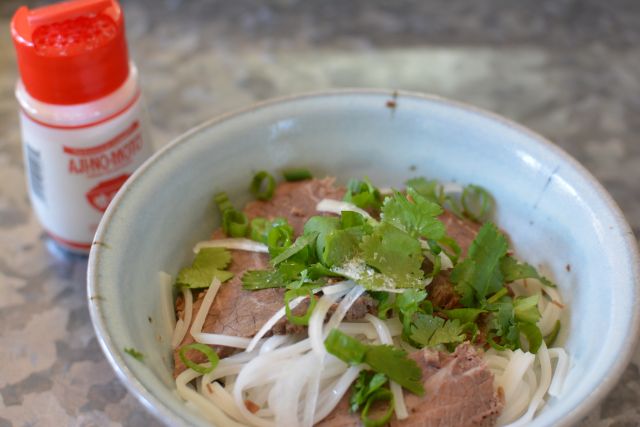
My husband says he doesn’t taste a difference when I put MSG in pho. He always finishes my homemade pho, whether or not it has MSG. For that reason, I don’t regularly use MSG in pho. I build plenty of savory-sweet, umami flavor with good ingredients and I don’t dilute the broth like many Viet cooks do to stretch their efforts and resources. I don’t regularly need or miss MSG.
However, when my pho seems a little off, I may try to right it with a little MSG. Sometimes it works and sometimes it doesn't. But I have the squat plastic dispenser of MSG in my cupboard to use as a seasoning or spice. It’s not an everyday ingredient in my kitchen but rather one that I tinker with. For example, when I'm looking for a sweet-savory lift, I ponder using MSG and sometimes try it out to see what happens. Similarly, when I need an instant, gentle sweet smokiness, I consider and maybe use Spanish smoked paprika.
MSG in Non-Asian Foods
People often associate MSG with Asian food but in fact, it’s quite prevalent in many non-Asian foods. You may already be eating MSG in popular snacks like Nacho Cheese or Cool Ranch Doritos and Pringles (check the nutrition label information). I noticed that Lawry’s low-sodium seasoning salt contains monopotassium glutamic acid (a non-sodium MSG alternative) and glutamic acid to give it a flavor boost.
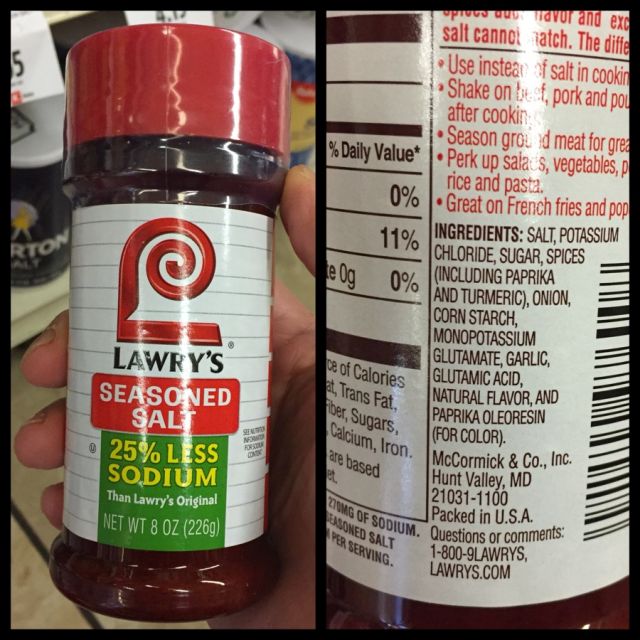
Kentucky Fried Chicken uses MSG and is transparent about it. You can check on allergens in KFC foods on this page. Select “All items” on the results page to see where MSG is employed. I wonder if they count MSG as one of the 11 herbs and spices. No wonder people around the world love KFC chicken.
Is MSG Harmful? What is MSG?
There is a lot of concern about MSG as a food ingredient. Over the weekend, the New York Times published an opinion piece about food phobias – a source of major stress for hosts and hostesses during the holidays.
The author, Aaron Carroll, a professor of pediatrics and Indiana University School of Medicine, sought to reduce people’s anxieties. “You Don’t Need to ‘Eat Clean’” tackled several common concerns, including gluten, GMO, and MSG. With regards to MSG, he wrote:
. . . MSG, or monosodium glutamate, is nothing more than a single sodium atom added to glutamic acid — an amino acid that is a key part of the mechanism by which our cells create energy. Without it, all oxygen-dependent life as we know it would die.
A 1968 letter in The New England Journal of Medicine started the frenzy; the writer reported feeling numbness, weakness and palpitations after eating at a Chinese restaurant. A few limited studies followed, along with a spate of news articles. Before long, nutrition experts and consumer advocates such as Ralph Nader were calling for MSG to be banned. The Food and Drug Administration never had to step in; food companies saw the writing on the wall, and dropped MSG voluntarily.
Many people still wrongly believe that MSG is poison. We certainly don’t need MSG in our diet, but we also don’t need to waste effort avoiding it. Our aversion to it shows how susceptible we are to misinterpreting scientific research and how slow we are to update our thinking when better research becomes available. There’s no evidence that people suffer disproportionately from the afflictions — now ranging from headaches to asthma — that MSG-averse cultures commonly associate with this ingredient. In studies all over the world, the case against MSG just doesn’t hold up.
Asian cultures are not averse to MSG. The Japanese came up with Ajinomoto and coined the term umami, which in Vietnamese is đậm đà, literally meaning bold.
Chefs and cooks these days often chase umami to create knockout flavors. In order to inspire calm, rational thinking about umami and better cultural understanding, influential chef and restaurateur David Chang has openly discussed the usage of MSG and its relationship to umami. In his 2012 presentation at the MAD Symposium (an annual, high-level international confab of chefs and food researchers), he explains MSG as a type of salt that may be used in measured quantities to create delicious food. MSG is a means to build umami.
He also points out (like many other people have) that glutamic acid naturally exists in many foods – such as fermented foods like kimchi, miso, soy sauce, and fish sauce, as well as Marmite, Vegemite, parmesan, dried mushrooms, and aged beef. Dried seafood and kombu (seaweed) have a lot of glutamic acid. These are all umami-bomb ingredients. Chang notes how humans are nurtured from early on to seek out the savory goodness associated with glutamates.
According to the FDA’s 2012 FAQ on MSG, MSG is synthetically made but it’s the same as its natural kin, glutamic acid. If you can eat a lot of parmesan and miso (foods high in amino acids), you can handle a little MSG.
Admittedly, I used to think I suffered from the kind of Chinese Restaurant Syndrome referenced in the NYT piece and Chang presentation. After my husband and I would eat a big dim sum lunch, we’d drive home feeling grouchy, sometimes squabbling over minor things. Somewhere along the 10 freeway, we’d look at each other and blame our behavior on the MSG at the restaurant.
But after researching and writing the Asian Dumplings cookbook, I realized that there can be a lot of sugar, salt and soy sauce in dim sum, in addition to MSG. When we over indulged on dim sum, we were loading up on a lot more salt and sugar than our normal intake. Our taste buds and glutamate receptors went into overdrive to send rapid-fire signals to our brains. We temporarily put our systems out of whack.
Our solution? We backed off eating so much dim sum and have not had the same kind of reaction since. Here’s a concise article explaining the need for glutamic acid and what happens when things go out of balance.
MSG Options and Substitutes
As eaters and cooks, you have options for dealing with MSG. Understand how MSG, glutamic acid and glutamates are used to create flavor. For example, glutamic acid is naturally part of hydrolyzed vegetable protein (HVP) and autolyzed yeast, which makes things like Better Than Bouillon taste so great to people. Three Crabs fish sauce contains HVP to give it a little extra something. They’re flavor enhancers.
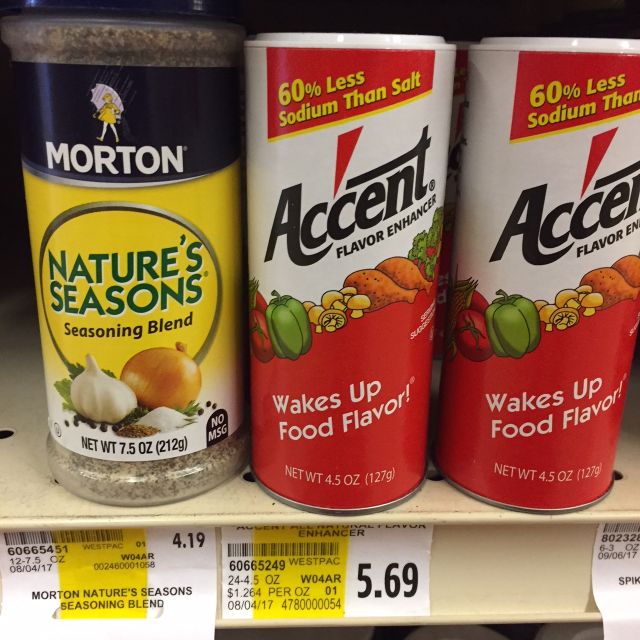
You do not have to employ synthetic MSG in your pho or other cooking. It is your choice. But maybe you may want to play around with it, like Carla Lalli Music, editor at Bon Appetit magazine, did in this story. MSG is sold at American supermarkets in the spice aisle as Accent. You may like it. (Why let someone else put it in your food when you can do it yourself?!)
Want to try another flavor enhancer that's devoid of MSG? Viet cooks gravitate toward bột nêm or hạt nêm, seasoning powders or granules; the popular brands are made by Knorr and contain MSG. They come in different flavors but the one I see most in mainstream and Asian markets in America is the chicken bouillon/stock powder.
I suggest you consider vegetable-based mushroom seasoning granules. Brands like Po Lo Ku Shiitake Mushroom Seasoning, Imperial Taste Mushroom Seasoning, and Takii Umami Powder do not contain MSG. (Take a look at them in the Joyce Chen fried rice post.)
For pho, I dilute the mushroom seasoning in water and let it sit for about 10 minutes then harvest the clear liquid on top; this prevents the powder from making the pho broth cloudy. I use the same approach with nutritional yeast, which has a certain amount of free-forming glutamic acid. See page 23 of The Pho Cookbook for greater details and recipes.
Demonizing MSG does not help much. Some cooks use MSG because it’s part of their cuisine, culture, and craft. The ingredient helps them create the appetizing, tasty foods that they’re aiming for. When used judiciously, MSG can be send a dish into a new realm of deliciousness. When used in excess as a crutch to mask poor ingredients or skill, that’s bad cooking. You’ll know it because the dishes all will taste the same. You'll be thirsty, too.
Some people may be extra sensitive to glutamic acid. If you’ve had issues, try avoiding dishes heavy in parmesan, ripe tomatoes, and miso, as well as foods containing MSG. Or do like I did and back off the dim sum and never finish the ramen or pho broth when eating out.
Read labels and be curious. No one is certain about the impact of MSG. The way to overcome fear is to educate and empower ourselves.
What are your experiences and thoughts on MSG, glutamic acid and glutamates? Weigh in!
Related posts:

















kara mae says
Wow this was a great overview!
I'm a slightly-above-average home cook who can't afford to go out to eat a lot and I freely admit to using MSG in a lot of dinners. It just adds a little bit of takeout-excitement to a home-made dinner. My favorite form is sazon goya or maggi.
However, it seems like the best thing about MSG is that it maybe doesnt need that layering that you need with many seasonings. If you can get away with just adding it to the bottom of the bowl to taste then.. why not.
Andrea Nguyen says
Kara Mae -- thank you for taking time to read and write. Your experience with using MSG is great. I love your clear explanation. When you're looking to hit a particular flavor, the little white crystals will get you there in a jiffy.
Candra says
Thank you for your informative article, Andrea! I always enjoy reading your blogs.
Whenever I ate in Asian restaurants, I would suffer from mouth ulcer, dry mouth, or throat sore, and sometimes I even had difficulty breathing afterwards. I didn't even know, then, that the symptoms were caused by MSG. It also depended on how much MSG was added. The more I consumed it, the severe symptoms I had. Eventually I came to a conclusion that MSG can cause health problems for those who are sensitive to the substance, while others are not strongly affected by it. I can recognize the taste of MSG as to claim that some non-Asian restaurants in Austria also use MSG for their dishes.
Andrea Nguyen says
Candra -- Too much of a good thing can totally send your body over the edge. 😉 It's great that you've identified the issue and detect the presence of high levels of glutamates in food. Being attuned to the foods we make and consume is vital. Too much outsourcing and you get in trouble! Thank you for sharing your experience from Austria.
Danial says
I’m part of an Asian (Malaysian) household so everyone’s familiar with MSG and Ajinomoto but my mom was quite spooked by how “unhealthy” it is and how it makes you feel thirsty it is used a lot in a dish. Thanks for clearing up the issues regarding this seasoning, I’m sure to share this with my mom!
Andrea Nguyen says
MSG does create a lot of thirst when used in excess. But as a friend of mine recently pointed, out, MSG exits your body so it's for a synthetic glutamate, it's not hanging around to do harm. Thanks for sharing your story!
joseph wouters says
Well here's my story on the use of msg in food. I 've been living in Thailand for 18 years now , don't eat too much streetfood anymore but rather go to the small open local restaurants. In all those years I have innumerable times experienced blister like burnings , seemingly coming from within my vains (?) and bursting outward, leaving ulcer-like little wounds, maily on my arms and hands each and every time I've been consumed food that was richely "poisoned" with an overdose of msg. I don't even taste it but my partner-cook does and always tells me whenever we're eating msg overdosed food , I count myself lucky that my body is messaging me that msg is to be avoided so I can comply, my doctor I probably have an allergy. For those of you who don't seem to suffer, I say, knowing my experience with msg, just think what it may be doing to your insides when over
consumed. Don't want to scare, just want to share.
Andrea Nguyen says
Thanks Joseph. Sounds like you were regularly expose to too much MSG and are highly sensitive.
Kip says
What a great post! Thank you for taking the time to write it. I'm truly grateful to writers like you in a time when food-writing is saturated with bad science and vacant descriptors like "yummy" and "nom." I especially appreciate the historical aspects here – I love reading about the science, but it's nice to see another angle too.
I'm glad you mentioned the sweet-savoury nature of MSG. I have seen recipes and products in Thailand that opt for a balance of salt and sugar to impart a savoury characteristic without using MSG. I had not, however, considered how to describe the flavour (normally when people ask I just give them some to see for themselves). Your words, "unique sweet-savory characteristic," are what I will respond with next time someone asks.
I don't use it in everything, but tofu boiled in salt + MSG water is heavenly. And I use it to cut some of the bitterness from the packet mix gravy my partner likes. I don't add it to everything I cook, much like I wouldn't put any other spice or herb in every single dish, but I always have Ajinomoto in my cupboard and it's a useful ingredient to have knocking about.
One thing I've yet to find the answer to: a Thai friend once told me Ajinomoto isn't the problem, but the 'fake one' is bad for you. She was under the impression there are two types of MSG, one that is safe and one that isn't. I've asked a few people about this over time but no one seems to have an answer. Any idea where that might come from?
Anyway, thanks again for such a thoughtful post.
Andrea Nguyen says
You're very welcome!
Charles Robinson says
I have been battling misinformation around MSG for years. When someone claims they are allergic to it, I ask how they are functioning since about 1% of the human brain is glutamate. It is absolutely critical to brain function, protein digestion, and muscles working. Some people are sensitive to high amounts of glutamates and it can cause all sorts of neurological and physical symptoms, but that is not the same as an allergy. For anyone interested in learning more about how glutamates are processed by the body, here is a neurotransmitter website with a lot of great information. I am in no way affiliated with them, I just found the information useful.
https://neurotransporter.org/glutamate.html
Andrea Nguyen says
Thanks for providing your insights and that link!
Laura says
I think it’s more the carbohydrates in the dim sum just make you wanna sleep. ?
Andrea Nguyen says
Yeah, dim sum is a heck of a carb overload!
Jo says
Awesome article. Thank you.
I've recently developed what I think might be an MSG-in-pho sensitivity and am deeply upset by the number of eateries I now have to avoid.
I'm in Australia. In the 1990s here people went a little bit MSG crazy and it led to Asian restaurants cutting back on MSG usage and putting signs in windows saying they are MSG free. Since I'd never been bothered by MSG this completely didn't affect me. Of course these days, MSG has found its way into all kinds of food, but I'm quite a homecooked kinda gal and don't consume too much junk food, so I'd say my consumption of MSG is low to moderate.
When I visit a few areas of Sydney that have strong Vietnamese communities I always stop for a thoroughly devine bowl of pho. And lately, when I eat in these kind of locations (as opposed to more 'mainstream' Viet restaurants) I end up with an absolutely appalling MSG reaction.
My theory is that I'm getting a stronger dose in the more Vietnamese-centered communities. But I also have a question about how they might make the broth. Do you know if MSG might build up or be concentrated in a kitchen that has a big pot of broth cooking day after day after day? Is it likely that the MSG is in the broth in the cookpot, or would it be added to the bowl on serving?
I know I could ask, but language barriers can be pretty high in areas where the best pho is served, and I've always felt it's a little disrespectful to give directions to the chef.
This is a pho-only problem for me at this stage, but given that a good bowl of pho is literally the elixir of life and I can't live without it I need to find a solution.
Andrea Nguyen says
You're on to something. I think they Viet-community cooks are using too much MSG along with salt and fish sauce. You're likely getting too much glumatic acid action in the broth, which is often diluted from a concentrated. Sometimes at the end of a service shift, the broth is very weak, cloudy, watered down and tastes of MSG. If you put lots of lime juice and sriracha in the bowl, you wouldn't know the MSG is in there. However, it's there.
When eating pho at a pho shop, I often leave broth in the bowl. Consider it a sauce. Maybe you'll make your own pho? It's the ultimate workaround.
Jay says
Normally, I do ok with small amounts of MSG. Larger amounts too, although I get extremely thirsty. But if I get a good dose of MSG and drink alcohol with it, I get flushed, hot, and my head feels like it is being squeezed in a vise.
Most people are probably not affected much by MSG. But the medical researchers don’t look for effects in individuals. They ignore the few that are affected severely.
Andrea Nguyen says
A little MSG usually doesn't harm folks. A lot of MSG when combined with lots of sodium from salt and other condiments in a dish is definitely overboard. So it's important to gauge tolerance and enjoyment levels. You've obviously been monitoring this and are aware. That's awesome.